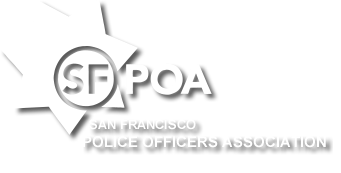Many parallels in duties and responsibilities
Teamwork on the Street Benefits Police Officers, Transit Supervisors, and the Public
By Ray Shine,
Retired, Co. K
All SFPD street cops know the woe of arriving at the scene of a collision involving a Muni bus and finding streets blocked by fire and medical vehicles, other Muni busses or streetcars, backed-up traffic, and crowds of passengers and pedestrians milling about in the collision scene. The confusion and the chaos hinder the response and investigative tasks of the officer. This is the sort of incident where the help of a Muni transit inspector can be of great service. On-scene transit supervisors can help to quickly clear the scene of backed up traffic by either moving a coach or re-routing uninvolved, backed-up coaches around the collision scene. They can direct people to temporary boarding areas, and help locate witnesses, and provide other necessary information about the involved coach, operator, and line. They are always approachable and eager to assist.
The similarities between the duties and tasks of uniformed street officers and uniformed Transit Supervisors are many. Both groups are charged with the basic efficiency of their respective organizations, and both groups conduct on-scene investigations of incidents, collisions, and public complaints. Both groups are virtually tethered to their dispatchers by radio and in-car (in-truck) computer terminals, write seemingly endless reports, and often are the direct recipients of public ire about issues within their organization that are often far beyond the scope of their professional responsibility.
Most police officers can readily recognize an MTA (or, more familiarly, Muni) transit supervisor. That person is usually wearing a light blue shirt, blue sweater-vest or a reflective jacket, and dark blue pants. Many also wear caps that have the MTA logo, and most also display a 6-point Transit Supervisor star somewhere on the outside of his or her uniform. They usually arrive at the scene of an incident in a marked, white pickup equipped with a yellow light bar and heavy push-bumper on the front. Despite the similar appearance to a uniformed police officer, MTA transit supervisors are not armed, do not have powers of detention or arrest, and are not authorized or equipped to operate any MTA vehicle in a Code-3 mode. They are empowered to issue parking citations for violations that directly impact Muni operations, such as blocking a bus zone or Transit-Only lane.
The role of Transit Supervisors is best understood by a police officer if one thinks of them as the “street sergeants” of Muni. They are the first-line supervision of the organization, and play the most critical part in the supervision of Muni line operations. Essentially, they are the agency’s eyes-on-the-street, and boots-on-the-ground. Nearly all have been promoted from the ranks of bus driver or rail operator. Those few who were not at one time drivers were most likely Muni Station Agents in the underground. In order to have been promoted, each transit supervisor must have placed well on a written civil service test and oral interview, have an exemplary employee record, and have successfully completed supervisory training and a year-long probation in grade.
Transit Supervisors are primarily responsible for ensuring that the agency’s drivers and operators adhere as closely as possible to respective line schedules, and to the rules and regulations of the agency. Their job is to post themselves at key locations around the city and closely monitor each passing transit vehicle, comparing it to a complicated printed matrix of line and run numbers, and if necessary direct operators to move coaches ahead or slow down in order to maintain the demanding headway schedules.
When dispatched, transit supervisors respond to all manner of incidents involving a Muni vehicle or uniformed employee. Typically those are collisions, falls on board, aggressive or assaultive passengers, medical calls, vandalism, break-downs, found property, blocked Muni routes, and any call for a supervisor by an operator. They are also often specially posted at large public gatherings such as athletic events, parades, or street fairs. They are also called upon to improvise go-arounds or to re-route temporary service past a collision, a police incident, fire response, extreme traffic congestion, or construction project that is blocking a designated Muni line.
When a Muni Transit Supervisor is dispatched to a collision or other incident where SFPD officers have also been sent, much of the work that each must perform is the same or very similar. The difference is not so much in the method of conducting what are seemingly parallel investigations and writing duplicate or redundant reports as it is in the function and direction of the report that each submits. Police reports are generally public documents that focus on violations of law, matters of seizure and/or arrest, and possible prosecution by the District Attorney’s office. Transit Supervisor reports are administrative in nature. Such reports focus on compliance to Muni rules and training, and are prepared under the umbrella of attorney-client privilege, and not readily available to the public or the media. SFMTA Labor Relations and/or the Office of the City Attorney will most likely conduct any necessary follow-up.
At-scene police officers would do well to solicit the assistance of any Muni transit supervisor, but also provide them with the information they need to do their job. They will need the SFPD case number, your unit call sign, your last name and star number, and a contact phone number. Cooperation is beneficial to both departments, and familiarity with regular transit supervisors enriches any officer’s base of resources. Next time you roll up on a crash or incident involving Muni, look for the man or woman in the blue shirt and introduce yourself. It’s very likely that you’ll be working with your new acquaintance many times in the course of your career.
Ray Shine is a retired SFPD sergeant who spent most of his 32-year career assigned to the Traffic Company. He now works part-time in the Safety Division of the SFMTA.

